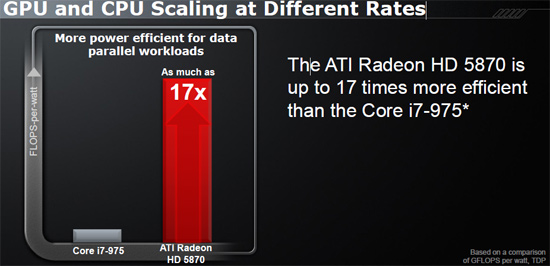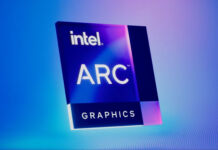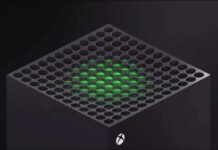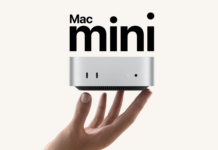AMD picks OpenCL to battle NVIDIA CUDA
Even if AMD’s most important feature of the Evergreen family is its DirectX 11 support, the Stream Computing concept may be a second key to success, at least we’re to believe competitor NVIDIA. General Purpose GPU applications is a fast growing market where NVIDIA has come a long way thanks to its licensed CUDA technology. The GPGPU concept is all about utilizing the massive parallel power of graphics processors not to draw 3D environments but to render videos, pictures or other fitting tasks.
AMD calls its GPGPU technology Stream and with RV870 it takes another shot at this. Basically we have the impressive floating point performance of Radeon HD 5800 series where HD 5870 boosts 2.7TFLOPs in single precision and 544 GFLOPS in double precision, which can be compared to NVIDIA’s professional Tesla C1060 graphics card that can output 78GFLOPS in double precision.
Graphics circuits humiliate processors in calculation capacity
AMD took the opportunity to compare its Radeon HD 5870 graphics card to Intel’s CPU flagship. Core i7-975 is the fastest desktop processor we have today, but as a generic CPU architecture it is nowhere near the floating point performance of RV870.

The comparison is made in GFLOPS per watt and shows that GPUs are better suited for heavy calculations
Disregarding the raw strength of the chip AMD wants to point out that its new DirectCompute 11 optimized architecture is a lot better suited for GPGPU applications, while it also supports the open OpenCL standard. The fact is that also NVIDIA is major supporter of the nonproprietary OpenCL standard, NVIDIA was actually the first to demonstrate OpenCL code on a GPU.
Khronos Group on OpenCL 1.0;
OpenCL (Open Computing Language) is the first open, royalty-free standard for general-purpose parallel programming of heterogeneous systems. OpenCL provides a uniform programming environment for software developers to write efficient, portable code for high-performance compute servers, desktop computer systems and handheld devices using a diverse mix of multi-core CPUs, GPUs, Cell-type architectures and other parallel processors such as DSPs.
Apple is actually the driving force behind the OpenCL standard that will be supported by Mac OS X 10.6. Apple that use graphics circuits from AMD, NVIDIA and Intel is in need of an open programming language, which excludes CUDA which is limited to NVIDIA hardware.
NVIDIA has a strong brand in CUDA but it also supports OpenCL that AMD is now betting on. AMD is the first semiconductor manufacturer to get OpenCL support with both GPUs and CPUs. How the GPGPU market will develop remains to be seen, but OpenCL 1.0 that is independent of the architecture of the circuits should be an interesting choice for many programmers.
AMD’s Radeon HD 5870 graphics circuit will at least offer calculation performance to go around. The ace up the sleeve is the DirectCompute 11 support through Microsoft’s DirectX 11 API. Exactly when NVIDIA will counter with its own DirectX 11 architecture is unknown at the time of writing





















